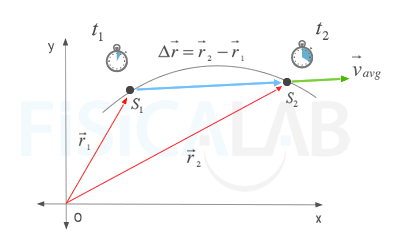The everyday concept of velocity arises when we consider how quick or slow a body is moving. Somehow we relate the displacement of the body with the time invested in it. In this section, we will define what is meant in physics by average velocity. This concept will help us understand other definitions related to velocity, that we will see in subsequent sections
Average velocity
The average velocity of a body that moves between two points P1 and P2 is defined as the ratio between the displacement vector and the time interval in which the displacement takes place. Its expression is given by:
where:
- t1, t2 : Time in which the body is in the initial P1 and final P2 points respectively
Additionally, the average velocity vector meets the following:
- If we use units of the International System (S.I.) in both the numerator (meters) and the denominator (seconds), we can deduce the dimensional equation of the average velocity [v]=[L][T]-1
- The unit of measurement in the International System (S.I.) for velocity is meter per second (m/s)
- The magnitude (the "size" of the vector) is equal to the magnitude of the displacement vector divided by the elapsed time
- The direction is the same as the direction of the displacement vector

Average velocity
The average velocity of a body (green) is a vector that has the same direction as the displacement vector (blue) and its magnitude is the ratio between the magnitude of the displacement vector and the elapsed time.
It is important to notice that the average velocity of a body in a time interval depends of the position vectors at the beginning and at the end of the motion. Although it may seem paradoxical, this implies that if the initial and final position coincide in that interval, the average velocity of the body will be 0.

